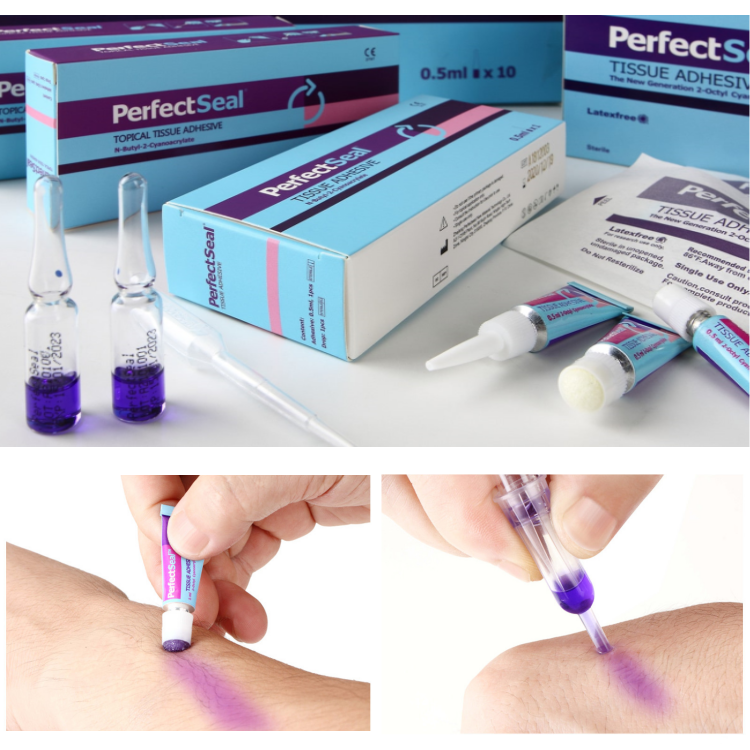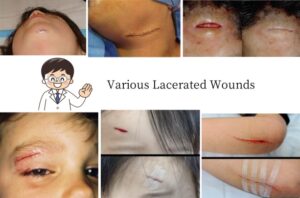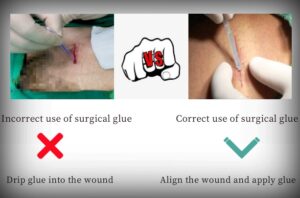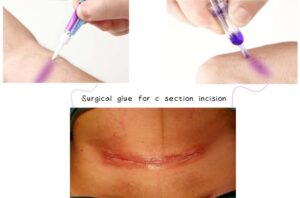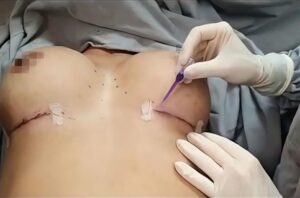What is circumcision?
Circumcision is the surgical removal of the skin covering the round tip of the penis, exposing the end of the penis. Usually, babies undergo circumcision shortly after birth.
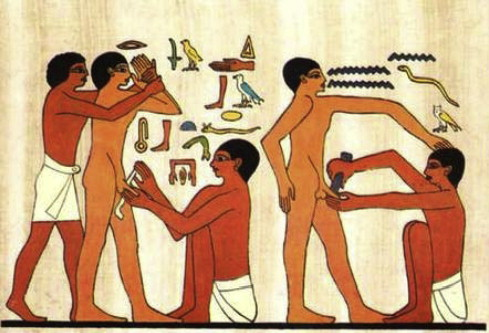
History of circumcision
Male circumcision is the oldest known human surgical procedure, with historical records and archeological evidence dating the practice back to ancient at least as early as 6000 BCE in ancient Egypt.
At that time, circumcision was a rite of passage for young men and later became a religious practice among Jews, Catholicism, Islam, and Muslims.
Why circumcision?
Medical reasons
Suffering from phimosis (tight foreskin): Circumcision is most commonly carried out when the foreskin is tight and won’t pull back (retract). In addition, circumcision can also reduce the risk of certain sexually transmitted infections, as well as urinary tract infections and penile cancer.
It also makes genital hygiene easier and may reduce the risk of inflammation and irritation of the foreskin.
Non-medical reasons
The cultural and religious beliefs of some countries. For example, Indonesia, Africa, Egypt, and other countries will perform male circumcision surgery.
Most non-medical circumcisions are carried out on children.
What are the benefits of circumcision?
- Improve hygiene
Circumcision reduces the accumulation of bacteria and other microorganisms that can cause an unpleasant odor.
- Decreased risk of urinary tract infections (UTIs)
UTIs can cause discomfort and pain, severe infections can even kidney damage. Some studies show a three- to ten-fold decrease in UTI rates in circumcised boys.
- Decreased risk of sexually transmitted infections
Circumcised men compared with uncircumcised men have also been shown in clinical trials to be less likely to acquire new infections with syphilis (by 42%), genital ulcer disease (by 48%), genital herpes (by 28% to 45%), and high-risk strains of human papillomavirus associated with cancer (by 24% to 47% percent).
- Prevention of penile problems
Circumcision can help prevent several penile problems, including phimosis, paraphimosis, and balanitis.
- Decreased risk of penile cancer
Men who were circumcised as children may have a much lower chance of getting penile cancer than those who were not.
In fact, some experts say that circumcision as an infant prevents this cancer. The same protective effect is not seen if circumcision is done as an adult.
What are the risks of circumcision?
Apart from the initial swelling, The most common complications of circumcision are bleeding, and infection. Other possible complications of circumcision can include excessive scarring, nerve damage, erectile dysfunction, and reduced sensitivity in the penis.
However, these risks are relatively rare, and most men who undergo circumcision experience few if any complications. The risk of complications tends to be higher in older males, those with certain medical conditions, or those who have a low pain threshold.
When is the best age for circumcision surgery?
Infant circumcision is typically performed between one to two months of age. Adult circumcision surgery is recommended to wait until semi-adolescence or during young adulthood.
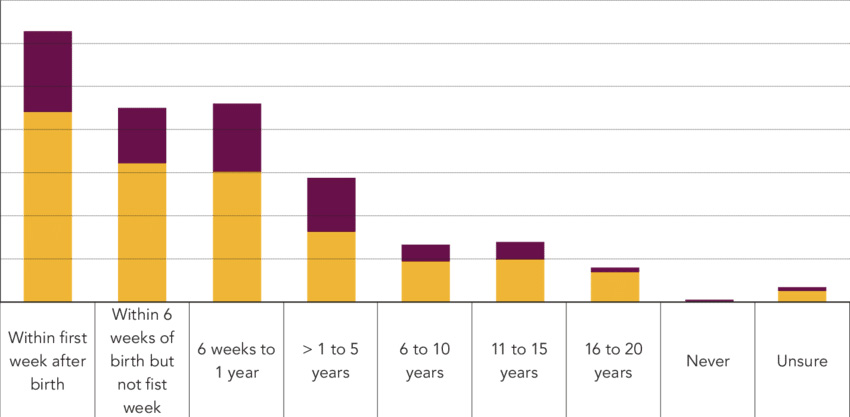
Circumcision procedure
What happens before a baby's circumcision?
The doctor may recommend giving the baby some acetaminophen to help with pain relief. In most cases before the procedure, the person doing the circumcision will:
- Place the baby on the circumcision board.
- Gently restrain the baby’s arms and legs, so his limbs don’t flail during the procedure.
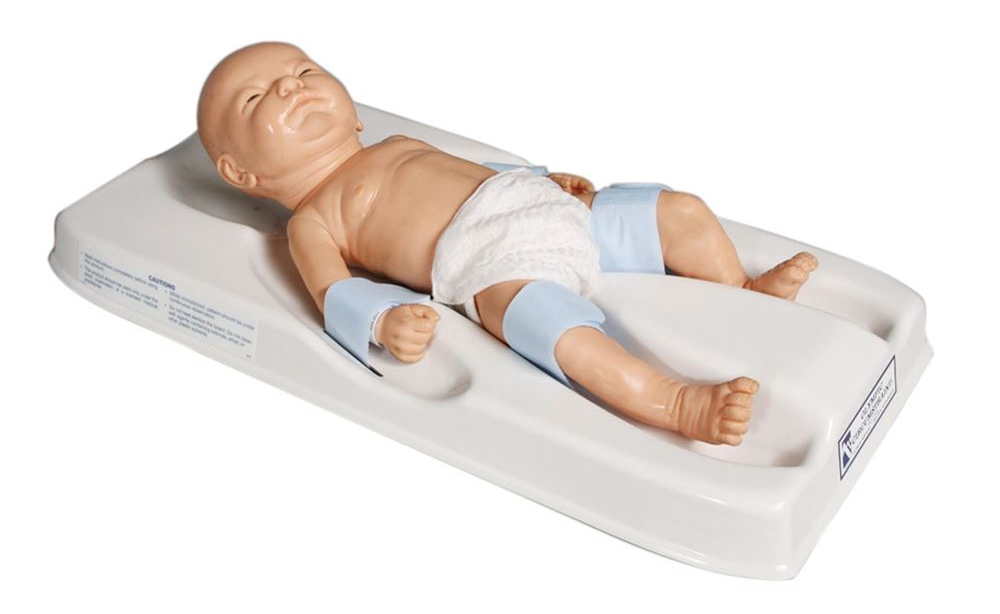
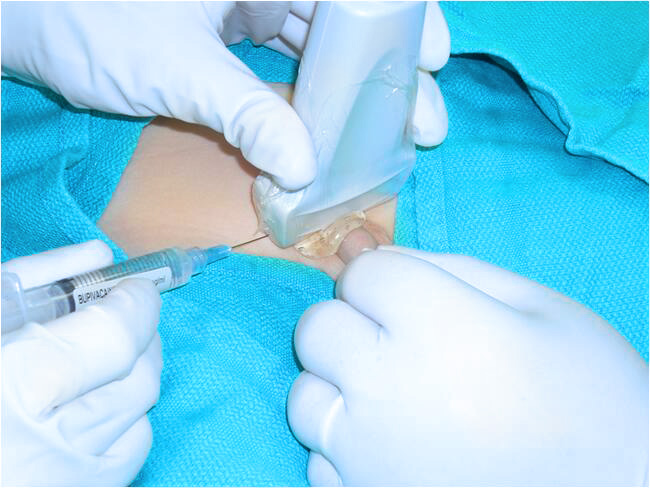
- Clean his penis and surrounding area.
- An anesthetic will be injected into the base of the penis or applied to the penis as a cream, so the baby won’t feel pain.
What happens during a circumcision?
The person doing the baby’s circumcision:
- Separates the foreskin from the head of the penis.
- Uses a scalpel to remove the foreskin.
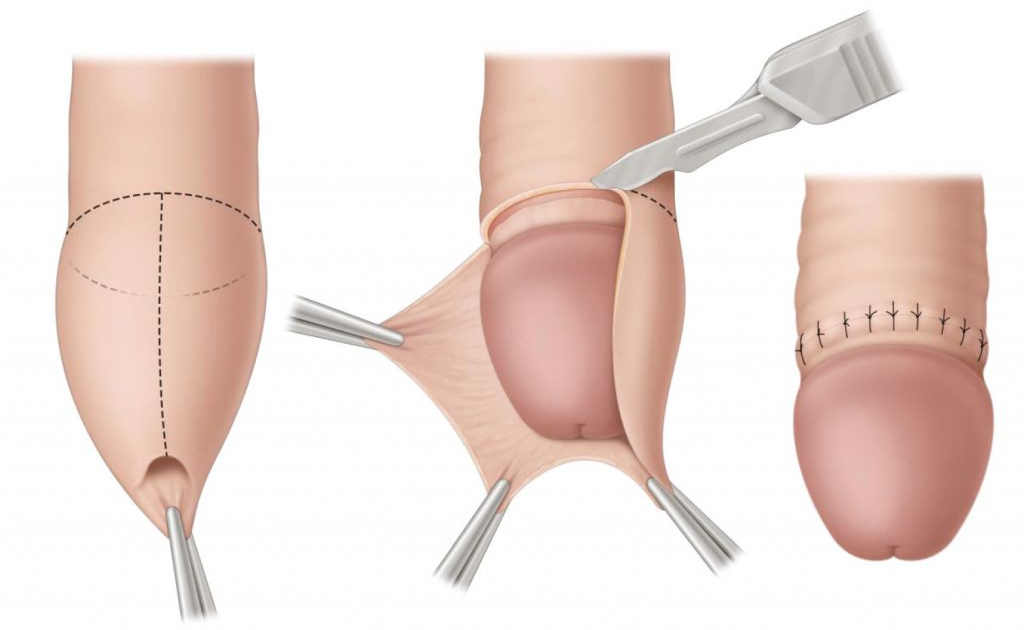
What happens after a circumcision?
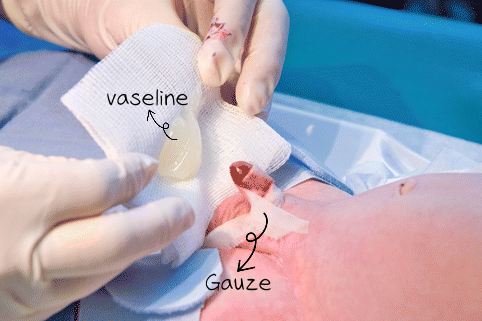
Immediately after removing the foreskin, the person doing the procedure applies ointment and wraps the penis in gauze.
What are the types of circumcision?
The most common types of circumcision are the following:
1. Traditional Circumcision (Dorsal Slit Technique)
In this procedure, the surgeon makes incisions along the upper length of the foreskin and then removes it, thereby exposing the glans penis.
Advantage
- The length of the resected foreskin is controllable
- Affordable and has a plastic function
- Suitable for patients of all ages, from neonates to adults
Disadvantages
- Complicated procedure.
- The operation time is long (30-45 minutes); so, the patient is in more pain, and anesthesia may be added during the operation
- Hemostasis is required during the operation
- The wound surface is relatively irregular
- The potential risks and complications associated, include bleeding, infection, and scarring.
- No bathing after surgery
- This recovery period is very long, about 4-5 weeks to recover completely
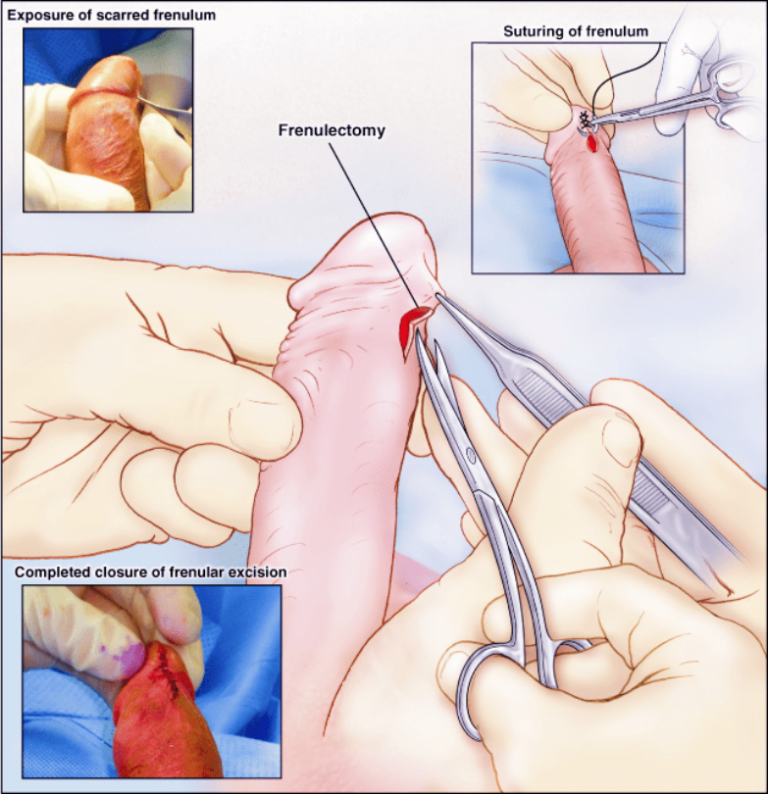
2. Circumcision Ring (metal ring, plastic ring, business ring, etc.)
Ring circumcision, also known as the Shang Ring method, unlike traditional circumcision methods that require sutures, the Shang Ring method uses a ring that is placed at the base of the foreskin and removed after a week or so.
Advantages over traditional circumcision methods
- Short operation time (about 10-15 minutes) that can be performed with minimal anesthesia.
- No hemostasis is required during the operation
- Less painful and less invasive alternative
- Lower rates of complications such as bleeding and infection
- The excision wound is neat
- You can take a bath after surgery
- More cost-effective
Disadvantages
- It may be necessary to come to the hospital for a lower ring after surgery (wounds, pain, bleeding during lower ring);
- Discomfort caused by the belt ring (foreign body sensation)
- Easy to edema
- Not be suitable for all individuals, as the size of the ring needs to be chosen according to the individual anatomy.
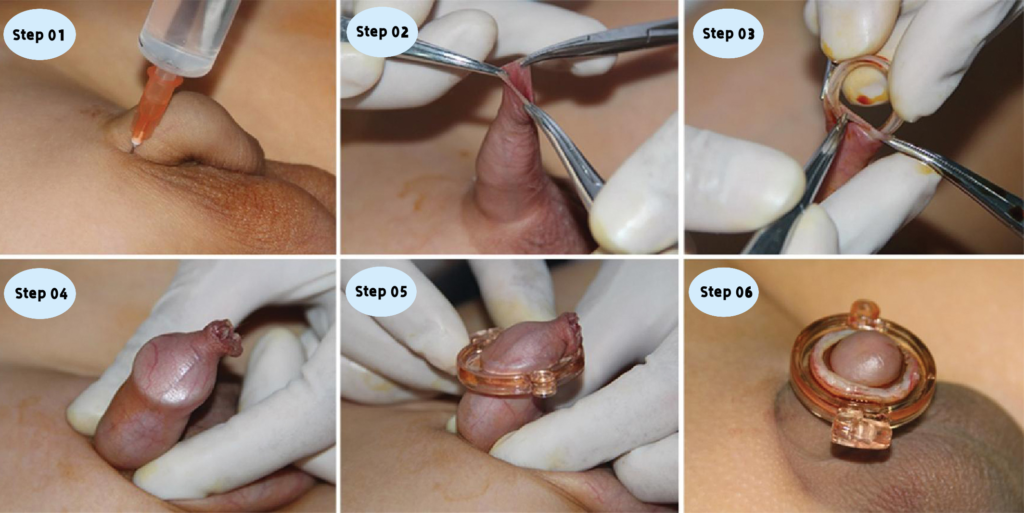
3. Laser circumcision (carbon dioxide laser, plasma, ultrasonic knife, electric knife, etc.)
Laser circumcision, also known as laser-assisted circumcision or laser frenuloplasty, is an advanced surgical minimally invasive procedure.
In this procedure, the surgeon makes use of a high-intensity laser beam for removing the layer of the foreskin.
Advantage
- No bleeding or pain was involved in the procedure
- Laser circumcision is 100% safe for every age group.
- Short operation time (about 10-15 minutes)
- Go home that day without hospitalization.
- No chances of postoperative infections.
- The recovery period is quite short and you can go about your routine tasks within 2-3 days.
Disadvantage
- More expensive than traditional methods
- The procedure can result in more scarring. Scar tissue can cause pain, discomfort, and even a reduction in sensitivity during sex.
- Affect the appearance of the penis and cause dissatisfaction with the results.
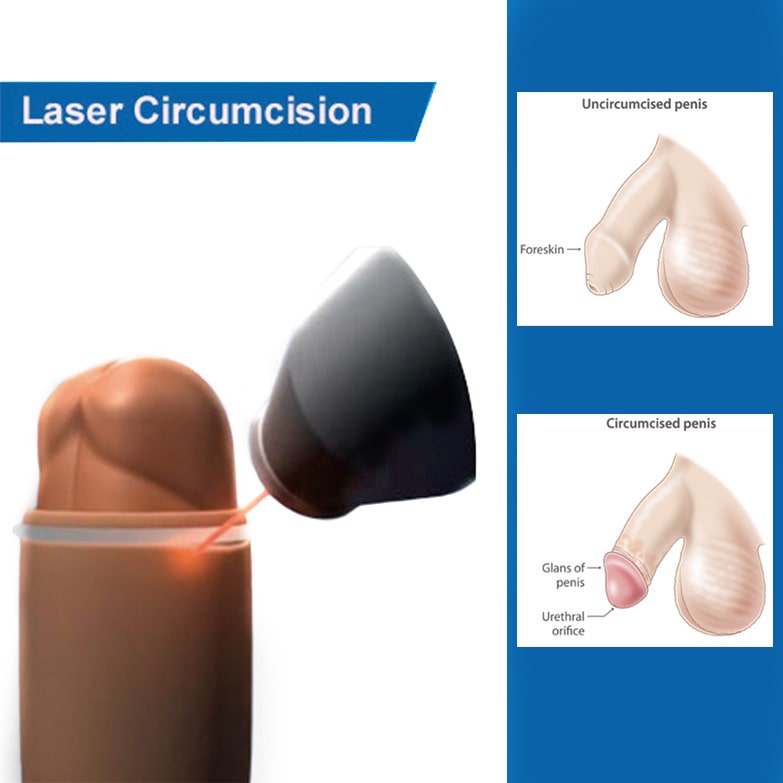
4. Circumcision Sleeve (coronal incision and penile base incision)
Sleeve circumcision is a type of less invasive alternative to complete circumcision. Where the excess foreskin is only partially removed, leaving a sleeve or cuff of skin remaining around the shaft of the penis.
Advantage
- Less tissue removal can help to maintain a greater sensitivity and natural appearance of the penis.
- The lower risk of complications such as excessive bleeding, scarring, or infection.
- Less time to heal
Disadvantage
- It can be more challenging to perform and should always be performed by a qualified healthcare professional.
- There is a risk of incomplete removal of the foreskin and the risk of penile cancer, sexually transmitted infections, and other related conditions may not be completely reduced.
- Not suitable for all cases, particularly if there is significant skin redundancy or if the foreskin is too tight.
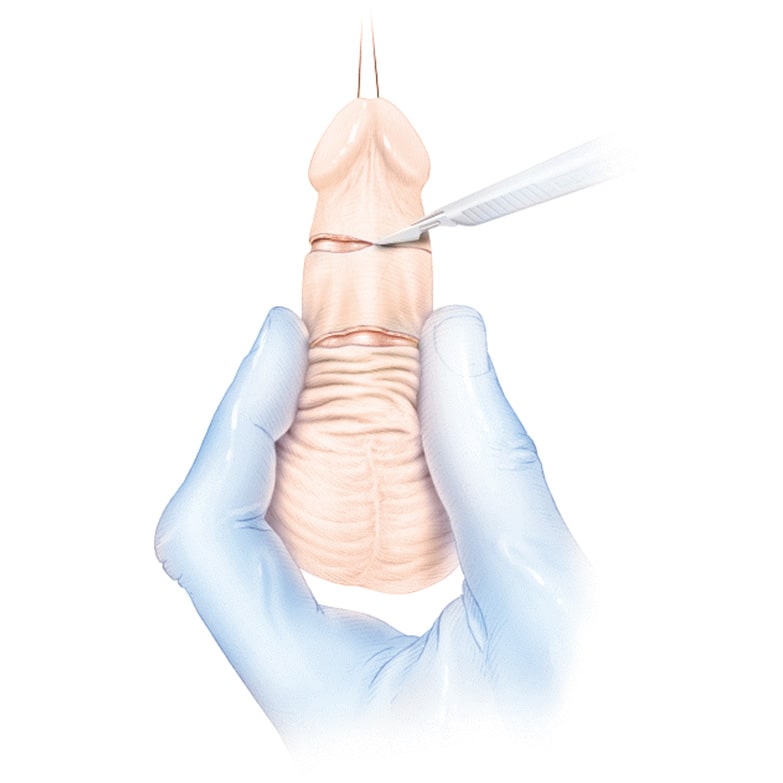
5. ZSR circumcision
ZSR circumcision is also known as stapler circumcision. The procedure involves inserting the penis into a circular stapler, which then pulls the foreskin over a clamp. The clamp is then secured and the foreskin is surgically removed using a circular blade.
Advantages
- Be quicker (about 30-45 minutes), safer, and less painful than traditional circumcision methods.
- Less bleeding, swelling, and pain compared to traditional circumcision methods.
- Go home within 6-12 hours after the procedure.
- The lesser recovery period, about 1 week to recover completely
- Reduces the risk of complications such as infection, scarring, and adhesions.
Disadvantages
- Costs for circumcision with a stapler were much higher than those for circumcision with stitches.
- Residual staple nails need to be removed
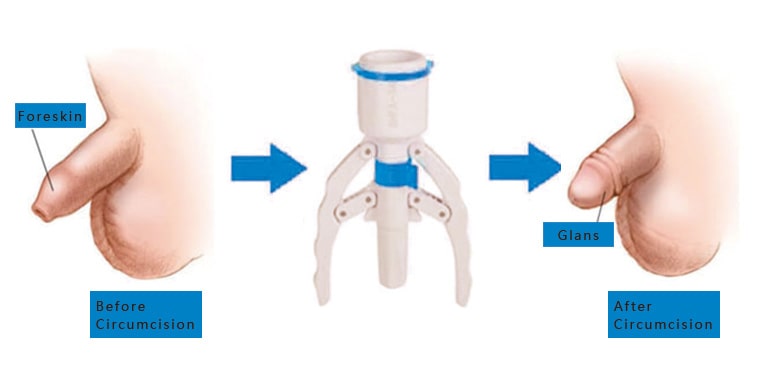
6. Circumcision Stitches
Circumcision stitches are typically used to close the incision made during a circumcision procedure. These stitches are usually made from dissolvable materials that break down over time, rather than requiring removal.
Advantages
- Quicker healing times and reduced risk of infection.
- Ensure that the wound is healed properly and prevent bleeding and infection.
Disadvantages
- If the stitches aren’t removed properly, they can cause pain and discomfort, and possibly lead to complications such as infection.
- The stitches can often become irritated and itchy, causing further discomfort.
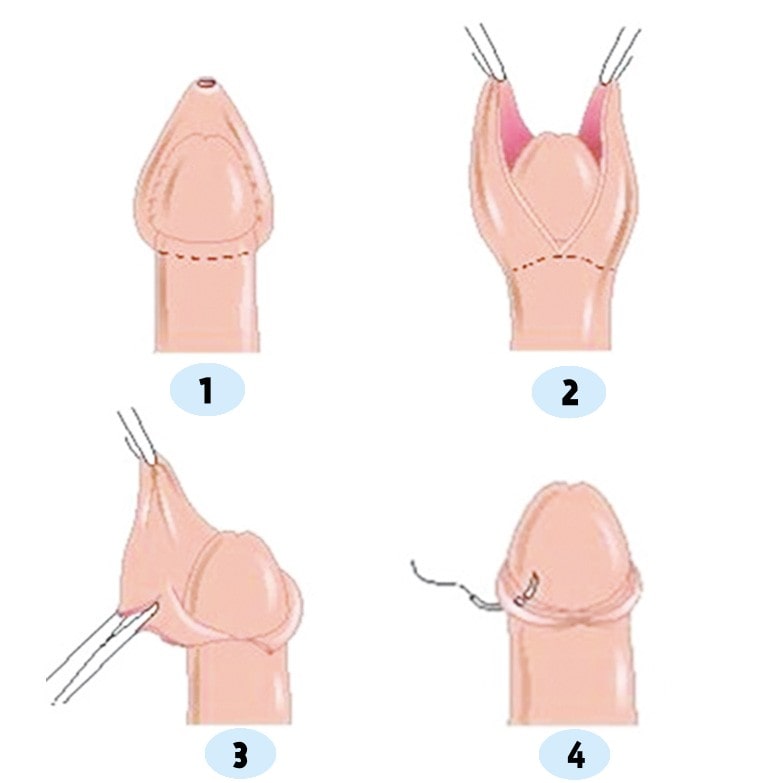
7. Skin Glue for Circumcision
Skin glue is a special medical tissue adhesive that applies to the circumcision wound edges that can be bonded together between the inner and outer foreskin edges. It can be used on its own or with stitches. It takes only 3-5 minutes to dry to set and form a thin protective waterproof coating over the wound.
Advantage
- The glue forms a strong, waterproof seal that helps reduce the risk of infection and scarring.
- Easy and quick process
- This will give a strong waterproof seal, less pain, less risk of infection, and better cosmesis results as compared to stitches
- No need to remove stitches, the glue usually comes off itself within 5-15 days
Disadvantage
- There is a risk of infection if the glue is not applied properly or if it becomes contaminated.
- Some patients may experience adverse reactions to the glue, such as skin irritation or an allergic reaction.
In the video, a doctor in Indonesia uses PerfectSeal® topical tissue adhesive to bond the inner and outer edges of the foreskin wound after child circumcision.
How much does circumcision cost?
The cost of the circumcision procedure depends on a variety of factors, including:
- Choice of treatment country, city, and hospital
- Cost of diagnostic tests and consultation
- Type of surgery
- Baby or adult
- Patient’s health condition
- The severity of the condition
- Surgeon’s fees
- Postoperative care required
- Choice of anesthesia
- Insurance coverage, etc.
The cost of circumcision in different countries is as follows:
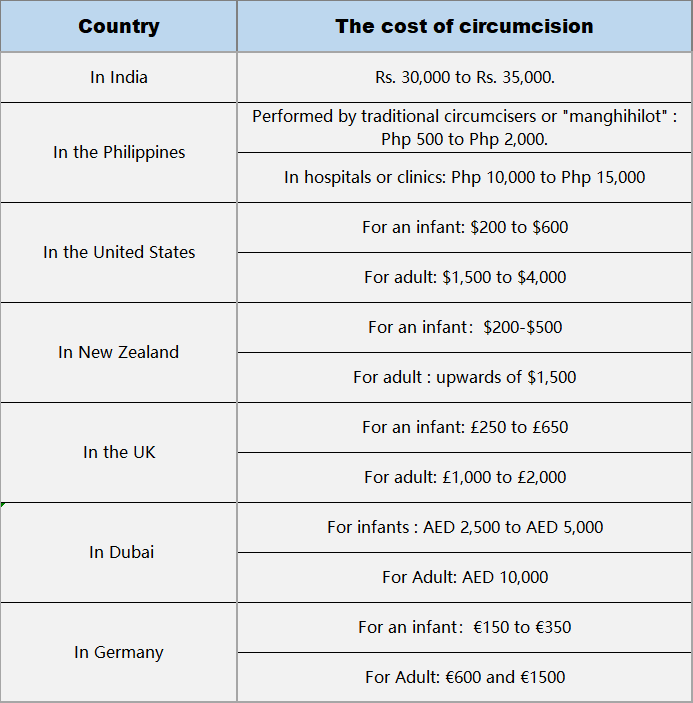
Although, these prices can vary widely based on the above factors. But, circumcision may be covered by insurance in some cases, so it is important to check with the insurance provider before making a decision.
Ultimately, the cost of circumcision should not be the only determining factor when considering the procedure, and consultation with a circumcision provider is recommended to determine the most appropriate method of circumcision.
How long does circumcision take to heal?
Recovery from circumcision takes about eight to 10 days. While the penis heals, it may look swollen and red. You may see a yellow film at the tip.
How to care for circumcision?
After the circumcision, you will need to take steps to care for your baby’s penis until it heals. This includes cleaning the area with warm water at least once daily, and whenever the area becomes dirty after a bowel movement. Allow the area to dry, and then apply petroleum jelly liberally to prevent irritation.
For care of a circumcision treated with surgical glue, pay particular attention to the following points:
- Wash your hand before you touch/change the bandage
- Only wear tight underwear with the head of the penis upwards toward the belly button.
- Avoid soiling the bandage with urine
- Do not touch the glue for 4 days, Keep the circumcision wound dry
- Change the bandage daily for 7 days
- Wrap the circumcision wound with cling film if you like to take a shower before 4 days.
- Do not soak or scrub your wound for 15 days.
- Do not apply liquid or ointment medications or any other product to the wound while the glue is in place. It could loosen the glue film before the wound is fully healed
- Do not scratch, rub, or pick at the glue; doing so may loosen the film before the wound is fully healed
- Do not swim until the adhesive film (glue) has fallen off naturally
- Do not do any heavy lifting, gym, or exercise for 2 weeks
- Do not do any sexual activities for 4-6 weeks
- Apply bio-oil on the wound after 4 weeks for 2-3 months to decrease the scarring
Signs of infection after circumcision
If you notice any of these problems, call your doctor right away:
- Lasting bleeding or blood on the diaper (more than quarter-sized)
increasing redness - Fever
- Other signs of infection, such as worsening swelling or discharge, or pus-filled blisters
- Not peeing normally within 8 hours after the circumcision
Effect of Circumcision
Does circumcision affect the length?
Penis size is also based on blood flow to the penile tissues. Removing a layer of skin tissue (the foreskin) — doesn’t have any impact on other penile tissues or how big your penis appears when erect. However, it may have slightly less “bulk” when it’s flaccid.
Does circumcision reduce pleasure?
Conclusion: The highest-quality studies suggest that medical male circumcision has no adverse effect on sexual function, sensitivity, sexual sensation, or satisfaction.
What does circumcision prevent?
In observational studies, circumcision has been shown to lower the risk of penile cancer, cervical cancer in female sexual partners, and infant urinary tract infections in male infants.
Besides, male circumcision can reduce a male’s chances of acquiring HIV by 50% to 60% during heterosexual contact with female partners with HIV, according to data from three clinical trials.
Other common FAQ
1. What is the circumcision cpt code?
CPT codes: 54150
Circumcision, using a clamp or another device with a regional dorsal penile or ring block
2. How common is circumcision in the world?
Circumcision rates around the world
About one-third of males worldwide are circumcised, although the prevalence of circumcision varies significantly by country and culture. It is most common among Muslims and Jews, as it is part of religious law in Judaism and is an established practice in Islam.
3. Can an adult get circumcised?
Yes. People who were not circumcised as babies may choose to undergo circumcision as an adult. Generally, the procedure is the same for older boys and adults as it is for babies.
4. Can I get phimosis again after circumcision?
Once the foreskin is removed through circumcision, there is zero possibility of recurrence of phimosis.
5. Does circumcision hurt?
The circumcision is performed under local anesthesia or general anesthesia, he will not experience any pain during the procedure.
After the procedure, for the first few days, you may feel pain and use simple pain relief medication. Take simple over-the-counter painkillers for a few days.
6. What is the best ointment for circumcision?
After the bandage is off, leave your penis open to the air and apply Vaseline or bacitracin ointment around the sutures, several times each day. This will prevent the dry edges of the incision from sticking to your clothes.
7. How long swelling or bruising will settle down?
The shaft of the penis will have swelling for 4-6 weeks and bruising of the glans and shaft of the penis will settle within 4 weeks.
8. What is the recovery time for adults after circumcision?
It usually takes at least 10 days for your penis to heal after circumcision. You’ll probably be advised to take at least 1 week off work to recover.
9. How long does glue stay on the circumcision wound?
The glue usually comes off itself within 7-15 days
10. Are there any alternative treatments if I do not want to get circumcised?
Under some circumstances, other treatments may be considered but circumcision remains the most common treatment option to relieve your symptoms. Alternatives to circumcision include:
Frenuloplasty – this is an operation to cut and lengthen your frenulum, which is the small tag of skin on the underside of your penis, between your foreskin and the shaft of your penis. If the frenulum is short or torn, you may have problems pulling your foreskin back.
Dorsal slit – in this procedure the foreskin is cut to widen and loosen it, so it can be pulled back more easily.
Prepuceplasty – this is more of a minor procedure than a circumcision. The foreskin is cut and stitched to widen it.
Your surgeon can explain these treatments if they are suitable for you
11. How long frenulum is will heal?
Sometimes we put a few stitch covers by glue at the frenulum which will take longer (about 4 weeks) to heal. Apply Fucidin cream after changing the bandage


